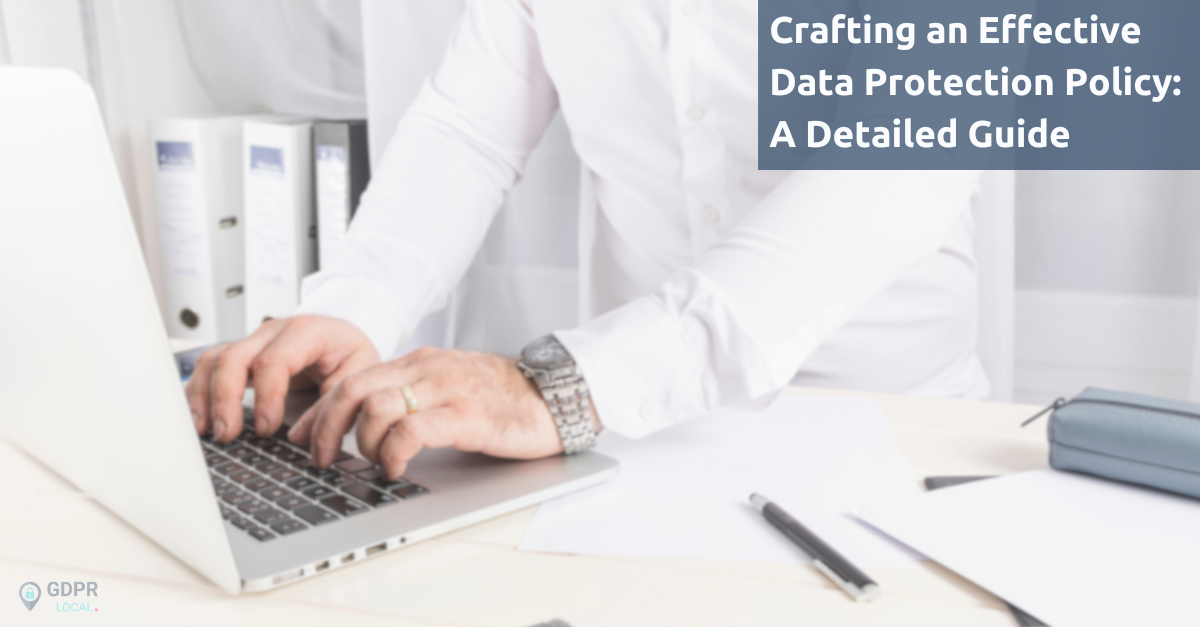
Crafting an Effective Data Protection Policy: A Detailed Guide
Protecting sensitive information is more than a necessity today – it’s critical responsibility. Protecting the integrity of an organization’s data and the privacy of its employees starts with crafting an effective data protection policy. It is essential not just for compliance with increasing regulatory requirements but for maintaining customer trust and securing business continuity. A well-structured data protection policy can mitigate risks associated with data breaches and cyber-attacks, safeguarding both the organization and its stakeholders from potential harm.
Creating a good data protection policy involves several key steps, starting with a thorough understanding of data protection principles. This process includes identifying specific organizational needs, developing a solid policy framework, and implementing effective measures to safeguard data. The goal is to align the policy with best practices and regulatory standards to ensure comprehensive protection of customer data. Customizable data protection policy templates enhance an organization’s ability to safeguard sensitive information.
Understanding Data Protection
Definition and Importance
Data protection involves safeguarding vital information from loss, corruption, or unauthorized access. It is crucial because it ensures the integrity and availability of data, which is essential for maintaining operational continuity and trust in any organization. The importance of data protection has escalated with the increasing amount of data generated daily, approximately 2.5 quintillion bytes worldwide. Effective data protection strategies prevent potential financial losses and reputational damage resulting from data breaches.
Legal and Regulatory Requirements
Globally, nations have enacted various data privacy laws that dictate the collection, use, and management of personal information. These laws aim to protect the privacy of individuals and provide them with control over their personal data. In the United States, while there is no single federal data privacy law, states have developed a complex array of laws that address specific sectors and mediums such as health information and financial data. The Federal Trade Commission (FTC) plays a pivotal role in enforcing privacy laws and protecting consumer rights under the Federal Trade Commission Act.
In Europe, the General Data Protection Regulation (GDPR) sets a benchmark for data protection, giving individuals significant control over their personal data and imposing strict penalties for non-compliance, which can reach up to 20 million euros or 4% of the annual global turnover of a company. Similarly, other countries have their specific regulations, like the Digital Personal Data Protection Act in India, which aligns with global standards like the GDPR.
State-specific laws in the U.S. such as the California Consumer Privacy Act (CCPA) offer rights to residents including the ability to know about, opt-out of the sale of, and delete their data collected by businesses. These legislative measures highlight the growing emphasis on data protection and the need for businesses to comply with an increasingly complex regulatory landscape to avoid severe penalties and legal challenges.
Identifying Data Protection Needs
Assessing Current Data Practices
To establish a good data protection policy, organizations must first assess their current data handling practices. This includes identifying which data is collected and determining its sensitivity. Sensitive data requires stringent protection measures due to the legal and regulatory frameworks governing its security. Understanding the lifecycle of data—from creation to destruction—is crucial in implementing effective security measures at each stage. This lifecycle typically includes stages such as creation, storage, use, sharing, archiving, and destruction.
Organizations should also evaluate their compliance with existing data protection regulations. Compliance dictates the deployment of specific security measures such as encryption, firewalls, access controls, and audit logs. These tools are essential not only for protecting data but also for tracing its usage and ensuring it is disposed of securely and in a timely manner.
Determining Data Sensitivity and Classification
Once the data practices are assessed, the next step is to classify the data based on its level of sensitivity. This classification guides the implementation of appropriate security measures and access controls. Data can generally be categorized into four levels: public, private, confidential, and restricted. Each category requires different security protocols to ensure data protection and compliance with relevant regulations.
For effective data classification, organizations can utilize various classification schemes such as role-based, data-oriented, access-based, or a hybrid approach. These schemes help in setting precise control mechanisms that are crucial for preventing unauthorized access and potential data breaches.
Implementing a classification system also involves understanding the criteria for data sensitivity, which includes confidentiality, integrity, and availability. Each criterion must be carefully evaluated to determine the appropriate security measures for protecting data based on its classification level.
By thoroughly assessing current data practices and determining data sensitivity and classification, organizations can tailor their data protection policies to effectively protect their sensitive information and ensure compliance with regulatory standards. This strategic approach not only protects the organization from potential data breaches but also builds trust with stakeholders by demonstrating a commitment to data security.
Developing a Data Protection Policy
Setting Goals and Objectives
When creating a data protection policy, setting precise and measurable goals is imperative. Data Privacy Officers utilize these goals as navigational aids, steering policy implementations and risk assessments to align with the overarching aim of protecting personal data. By establishing clear objectives, organizations ensure that every action taken adheres to these goals, enhancing their ability to address privacy challenges proactively.
The objectives of a data protection policy should be clearly defined to include the extent of data protection required, the strategies and policies to be deployed, and the legal and compliance stipulations that must be adhered to. The policy complies with GDPR regulations and is tailored to the organization’s specific needs.
Defining Roles and Responsibilities
A well-defined data protection policy outlines the roles and responsibilities of various stakeholders within the organization. At the core, the data controller bears the ultimate responsibility for the data being processed. They decide the purposes for which data is processed and are accountable to both the data protection authorities and the data subjects. In cases of data mishandling or breaches, the data controller is liable for damages and may face fines or restrictions on further data processing.
The data controller must ensure that any third parties processing the data, known as data processors, do so legally. This is typically managed through a Data Processing Agreement (DPA), which specifies how data processors can use, store, and delete personal data. The DPA serves as a legal tool to ensure that data processors adhere to the law, even when processing is outsourced.
Furthermore, the roles of data custodians and individuals explicitly accountable for data protection activities should be clearly articulated. This includes specifying who is responsible for implementing security controls, who oversees data integrity, and who handles breach notifications and compliance monitoring.
Organizations must also define the responsibilities of data owners and administrators. Data owners approve access, specify appropriate controls based on data classification, and ensure compliance with these controls. Administrators process, store, recover information, implement data owner-specified controls, and evaluate control effectiveness.

Implementing Data Protection Measures
Technical Safeguards
Technical safeguards are crucial in securing electronic protected health information (ePHI). These include implementing policies and procedures that limit access to authorized individuals only. The Health Insurance Portability and Accountability Act (HIPAA) Security Rule mandates covered entities to enforce three types of safeguards: technical, physical, and administrative. Technical safeguards involve the technology and the procedures that protect and control access to ePHI. For example, access controls must be set to allow only those granted specific access rights, and mechanisms must be in place to verify that a person seeking access to ePHI is indeed who they claim to be. Furthermore, encryption is a recommended method for protecting ePHI, both at rest and in transit, ensuring that data is unreadable to unauthorized users.
Audit controls are another significant aspect of technical safeguards. These are used to record and monitor activities related to ePHI, helping covered entities to ensure that ePHI is not altered or destroyed improperly. Implement systems to automatically log off users from their workstations and prevent unauthorized access. This approach ensures the integrity and confidentiality of sensitive health information.
Administrative Controls
Administrative controls form the backbone of a data protection strategy by managing the human elements of security. They encompass the policies and procedures that dictate acceptable employee conduct and the correct use of technology within the organization. One critical procedure is the authorization and supervision of access privileges, ensuring that only necessary personnel have access to sensitive information. Trustworthy and competent personnel fill roles by following workforce clearance procedures during the hiring process.
Training and awareness programs are essential, providing ongoing education to staff about the organization’s security policies and emerging threats. These programs are not one-off events but continuous efforts to maintain a high level of security awareness among employees. Additionally, managing termination procedures effectively revokes access rights and secures sensitive information when an employee leaves the organization.
Proper administrative controls also include monitoring login attempts and unusual access patterns, which can indicate potential security threats. Policies should be in place for responding to and mitigating security incidents, ensuring that the organization can quickly address and recover from breaches.
Conclusion
Having a solid data protection policy is more important than ever. It not only shields against potential threats but also shows a company’s dedication to protecting personal and sensitive information. As we look ahead, it’s crucial for businesses to regularly review and update their data protection strategies to keep up with technological progress and regulatory updates. This proactive stance on data protection will set businesses apart, boosting their credibility and ability to handle cybersecurity challenges effectively.
FAQs
How can I develop a data protection policy for my organization?
When crafting a data protection policy, consider these essential practices: regularly update the policy, secure consent before collecting data, perform a Data Protection Impact Assessment (DPIA), limit data collection to what is necessary, and establish both proactive and reactive strategies to handle data securely.
What steps are involved in creating a data security policy?
To establish a data security policy, you should follow these steps: draft the policy document, decide which data it will apply to, set up the rules for handling data, and finally, activate the policy.
What are the key steps to setting up a data protection program?
Building a data protection program involves several critical steps: create a project roadmap, define roles and responsibilities, conduct data discovery and classification, implement measures to protect data, continuously monitor and audit data privacy performance, and develop a training plan for involved parties.
What are the initial four steps in ensuring data protection?
The first four fundamental steps to protect data include identifying the data that needs protection, discovering its location and flow within your organization, classifying it according to sensitivity, and securing it with appropriate measures. Following these steps will help you safeguard valuable and confidential information effectively.